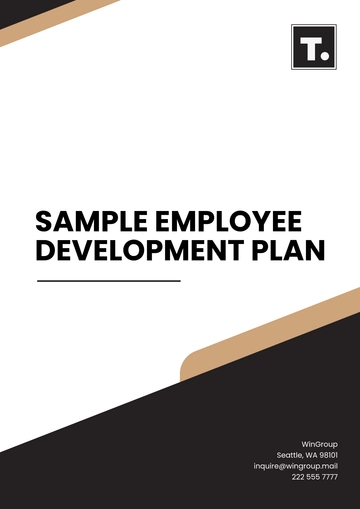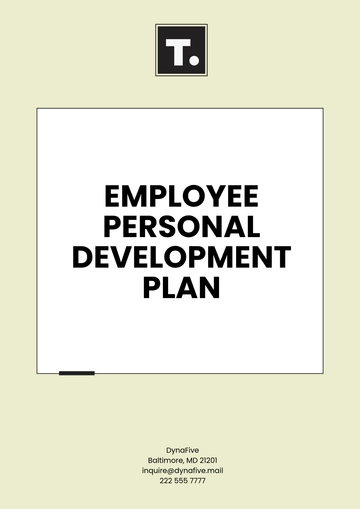Free Product Development 5-Year Plan

Company Name: [Your Company Name]
Date: [Insert Date]
1. Executive Summary
Overview: This plan outlines our strategic approach to product development from 2050 to 2055, focusing on innovative solutions in the renewable energy sector. Our mission is to empower consumers and businesses to transition to sustainable energy sources while achieving economic growth.
Key Objectives:
Product Launches: Introduce three innovative products by 2052, enhancing our market presence.
Market Share Growth: Aim for a 20% increase in market share by 2055 through strategic marketing and partnership initiatives.
Sustainability Commitment: Ensure all new products meet or exceed environmental standards.
2. Market Analysis
Industry Overview:
The renewable energy market is projected to expand at a CAGR of 25% from 2050 to 2055, driven by increasing consumer awareness and governmental incentives.
Regulatory policies favoring green energy are expected to enhance market growth and consumer adoption.
Target Market:
Focus on environmentally conscious consumers aged 25-45, particularly urban dwellers seeking sustainable energy solutions for their homes and businesses.
Secondary market includes commercial enterprises aiming to reduce operational costs through renewable energy solutions.
Competitive Landscape:
Key competitors include EcoPower Corp, Solar Solutions Inc., and GreenTech Innovations. Our analysis indicates that while they excel in established markets, there are gaps in innovative product offerings that we can capitalize on.
3. Product Vision and Strategy
Vision Statement:
"To be a global leader in sustainable energy solutions, providing cutting-edge products that empower consumers to reduce their carbon footprint while enhancing their quality of life."
Strategic Goals:
Year 1 (2050): Complete comprehensive market research to identify consumer needs and preferences.
Year 2 (2051): Launch a revolutionary solar battery storage system designed to optimize energy consumption.
Year 3 (2052): Develop and release smart home integration features, allowing consumers to manage energy use effectively.
Year 4 (2053): Expand our product line to include high-efficiency solar panels and energy management software.
Year 5 (2054): Analyze market impact, gather consumer feedback, and plan for future innovations based on evolving technologies and customer needs.
4. Product Roadmap
Year 1 (2050):
Q1: Conduct market research and consumer surveys.
Q2: Analyze research data and identify key product features.
Q3: Initiate prototype development based on consumer feedback.
Q4: Validate prototypes with focus groups.
Year 2 (2051):
Q1: Finalize design and initiate manufacturing of the solar battery storage system.
Q2: Launch marketing campaign.
Q3: Product launch and initial sales.
Q4: Gather customer feedback for improvements.
Year 3 (2052):
Q1: Begin development of smart home integration features.
Q2: Conduct beta testing with select customers.
Q3: Official launch of smart home features.
Q4: Assess market response and refine the product.
Year 4 (2053):
Q1-Q2: Develop and launch a new line of high-efficiency solar panels.
Q3-Q4: Introduce energy management software to optimize usage.
Year 5 (2054):
Q1-Q2: Comprehensive review of product performance.
Q3: Plan for next-generation product development based on feedback and market trends.
Q4: Set new strategic goals for the next five years.
5. Research and Development (R&D) Plan
Innovation Strategy:
Collaborate with leading universities and research institutions to explore new technologies, such as advanced photovoltaic materials and energy storage solutions.
Technological Requirements:
Invest in state-of-the-art manufacturing facilities to ensure quality and efficiency.
Implement robust data analytics tools for continuous improvement and product iteration based on user feedback.
6. Financial Projections
Budget Overview:
Annual R&D Budget: $2 million, allocated for prototype development, testing, and personnel.
Marketing Budget: $500,000 annually, covering digital marketing campaigns, trade shows, and promotional materials.
Revenue Projections:
Anticipated revenue of $1 million from the solar battery system in the first year post-launch, with projected growth to $5 million by year three as market adoption increases.
7. Marketing and Sales Strategy
Positioning:
Position our products as premium quality, focusing on sustainability, innovation, and user-friendly technology.
Sales Channels:
Direct sales through our e-commerce platform and partnerships with home improvement retailers and energy solution providers.
Promotional Strategies:
Implement targeted digital marketing campaigns emphasizing eco-friendly benefits, utilizing social media, SEO, and influencer partnerships.
Participate in industry trade shows and local sustainability events to showcase products and engage with potential customers.
8. Risk Management
Risk Assessment:
Identify risks such as regulatory changes, supply chain disruptions, and market volatility.
Mitigation Strategies:
Establish relationships with multiple suppliers to ensure flexibility in sourcing materials.
Regularly monitor regulatory developments and adjust strategies accordingly.
9. Key Performance Indicators (KPIs)
Metrics:
Product launch success rate (target: 90%).
Customer satisfaction scores (target: 90%+).
Year-over-year revenue growth (target: 30%).
Market share increase (target: 20% by 2055).
10. Implementation Plan
Action Steps:
Q1 2050: Complete market research and analyze consumer needs.
Q2 2050: Finalize product features based on research findings.
Q3 2051: Launch the solar battery system, followed by an aggressive marketing push.
Team Roles and Responsibilities:
Product Manager: Oversee product development and manage timelines.
Marketing Manager: Lead promotional campaigns and track their effectiveness.
R&D Team: Conduct research, prototype development, and testing.
11. Review and Adaptation
Monitoring Process:
Implement quarterly reviews of product development milestones and financial performance to ensure alignment with strategic goals.
Feedback Mechanism:
Utilize customer surveys, product reviews, and focus groups to gather insights post-launch, facilitating continuous improvement and innovation.
- 100% Customizable, free editor
- Access 1 Million+ Templates, photo’s & graphics
- Download or share as a template
- Click and replace photos, graphics, text, backgrounds
- Resize, crop, AI write & more
- Access advanced editor
Unlock your product's potential with the Product Development 5-Year Plan Template from Template.net. This editable and customizable tool allows you to outline strategies, set milestones, and track progress. Effortlessly modify your plan using our AI Editor Tool, ensuring alignment with your vision and goals. Start building a successful future today!
You may also like
- Finance Plan
- Construction Plan
- Sales Plan
- Development Plan
- Career Plan
- Budget Plan
- HR Plan
- Education Plan
- Transition Plan
- Work Plan
- Training Plan
- Communication Plan
- Operation Plan
- Health And Safety Plan
- Strategy Plan
- Professional Development Plan
- Advertising Plan
- Risk Management Plan
- Restaurant Plan
- School Plan
- Nursing Home Patient Care Plan
- Nursing Care Plan
- Plan Event
- Startup Plan
- Social Media Plan
- Staffing Plan
- Annual Plan
- Content Plan
- Payment Plan
- Implementation Plan
- Hotel Plan
- Workout Plan
- Accounting Plan
- Campaign Plan
- Essay Plan
- 30 60 90 Day Plan
- Research Plan
- Recruitment Plan
- 90 Day Plan
- Quarterly Plan
- Emergency Plan
- 5 Year Plan
- Gym Plan
- Personal Plan
- IT and Software Plan
- Treatment Plan
- Real Estate Plan
- Law Firm Plan
- Healthcare Plan
- Improvement Plan
- Media Plan
- 5 Year Business Plan
- Learning Plan
- Marketing Campaign Plan
- Travel Agency Plan
- Cleaning Services Plan
- Interior Design Plan
- Performance Plan
- PR Plan
- Birth Plan
- Life Plan
- SEO Plan
- Disaster Recovery Plan
- Continuity Plan
- Launch Plan
- Legal Plan
- Behavior Plan
- Performance Improvement Plan
- Salon Plan
- Security Plan
- Security Management Plan
- Employee Development Plan
- Quality Plan
- Service Improvement Plan
- Growth Plan
- Incident Response Plan
- Basketball Plan
- Emergency Action Plan
- Product Launch Plan
- Spa Plan
- Employee Training Plan
- Data Analysis Plan
- Employee Action Plan
- Territory Plan
- Audit Plan
- Classroom Plan
- Activity Plan
- Parenting Plan
- Care Plan
- Project Execution Plan
- Exercise Plan
- Internship Plan
- Software Development Plan
- Continuous Improvement Plan
- Leave Plan
- 90 Day Sales Plan
- Advertising Agency Plan
- Employee Transition Plan
- Smart Action Plan
- Workplace Safety Plan
- Behavior Change Plan
- Contingency Plan
- Continuity of Operations Plan
- Health Plan
- Quality Control Plan
- Self Plan
- Sports Development Plan
- Change Management Plan
- Ecommerce Plan
- Personal Financial Plan
- Process Improvement Plan
- 30-60-90 Day Sales Plan
- Crisis Management Plan
- Engagement Plan
- Execution Plan
- Pandemic Plan
- Quality Assurance Plan
- Service Continuity Plan
- Agile Project Plan
- Fundraising Plan
- Job Transition Plan
- Asset Maintenance Plan
- Maintenance Plan
- Software Test Plan
- Staff Training and Development Plan
- 3 Year Plan
- Brand Activation Plan
- Release Plan
- Resource Plan
- Risk Mitigation Plan
- Teacher Plan
- 30 60 90 Day Plan for New Manager
- Food Safety Plan
- Food Truck Plan
- Hiring Plan
- Quality Management Plan
- Wellness Plan
- Behavior Intervention Plan
- Bonus Plan
- Investment Plan
- Maternity Leave Plan
- Pandemic Response Plan
- Succession Planning
- Coaching Plan
- Configuration Management Plan
- Remote Work Plan
- Self Care Plan
- Teaching Plan
- 100-Day Plan
- HACCP Plan
- Student Plan
- Sustainability Plan
- 30 60 90 Day Plan for Interview
- Access Plan
- Site Specific Safety Plan





























